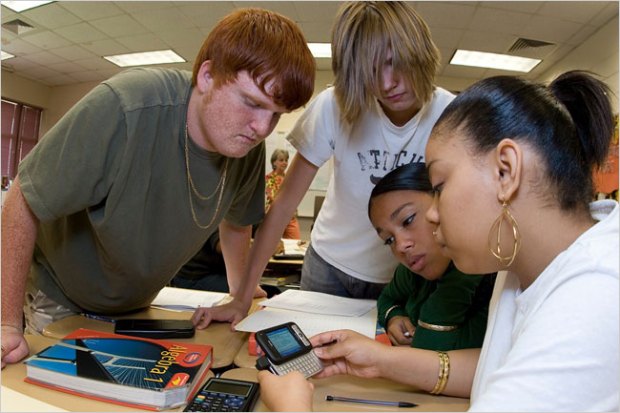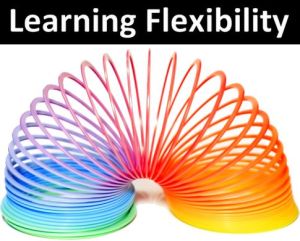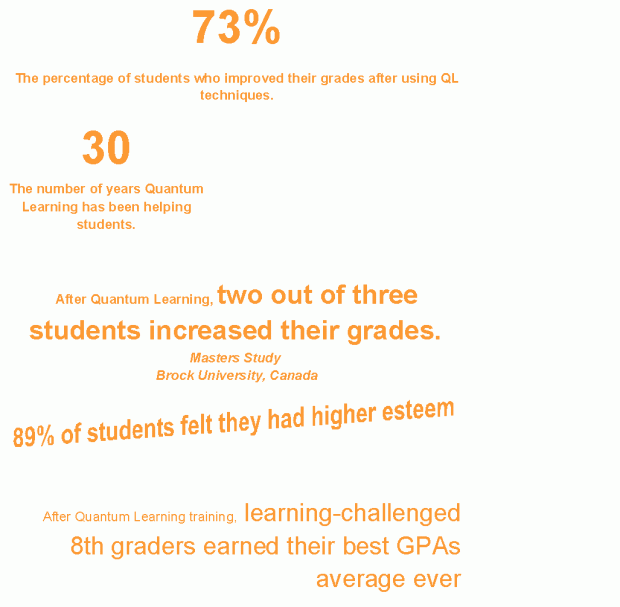Archive for category QL in the Classroom
Four Ways to Keep Your Students Attention
Posted by Quantum Learning Education in New Teacher Tips & Training, QL in the Classroom, Teacher Support on August 16, 2011
 Here at Quantum Learning, we know how important it is to communicate effectively. As an educator, making sure you are not only teaching the correct material, but doing so effectively can be harder than it seems. Everyone learns differently. We all know some people are more visual, while others may be more auditory or kinesthetic learners . But how can you make sure you are reaching your students 99 percent of the time?
Here at Quantum Learning, we know how important it is to communicate effectively. As an educator, making sure you are not only teaching the correct material, but doing so effectively can be harder than it seems. Everyone learns differently. We all know some people are more visual, while others may be more auditory or kinesthetic learners . But how can you make sure you are reaching your students 99 percent of the time?
Engage
The dictionary defines engage as, “to occupy the attention or efforts of (a person or persons).” How do you engage your students? Are you making sure you reach them visually, auditorily, and kinesthetically (VAK)? Are your lessons interesting and reach them in their reality (schema)? If not, how can you not only teach them the content, but in an engaging way?
Command attention. Not in a drill sergeant sort of way, but in an exciting relevant way. A student’s schema is what they relate to. For instance, if you see the Golden Arches, you know that there is a McDonald’s. This is because your schema told you so.
To get inside a student’s schema, you need to stay current on trends that relates to whatever age your students are. Listen to how they talk, pick up what’s exciting in their world, and see if you can explain your lesson plans in their world.
Interact
How many times have you been in a classroom and the teacher simply stands up and talks for an hour? I’m sure you all have sat through a class like this. Where you excited to get to class? Did you enjoy the monotone lecture? Chances are, you didn’t. Take a step back and ask yourself if you are inadvertently doing the same thing.
What can you do to interact with your students? How about moving around, making your students have to work to see you. This gets their blood flowing, and yours as well. Get them involved in the conversation. Have them help demonstrate something too. The more they can interact, the more you are keeping their attention.
Relevant
This goes hand in hand with schema. Being relevant is extremely important to your students. If you talk about things that are going on currently, you are more likely to get them engaged and interacting with your lesson. Teaching history? Find a way to use current news stories as a parallel to what may or may not be happening in your lesson for the day.
Tone of Voice
This may seem like a little aspect to your delivery, but tone of voice can be a great tool. Using slight inflections in your voice can keep your students attention, and auditorily highlight key points. In the same respect, you don’t want to sound angry or offensive in your delivery. Too many highs and lows can also be distracting, and sound less professional. It will take time to get your voice exactly the way you want it, but you can do it.
What techniques have you found useful to keep your students attention? Let us know in the comments below.
Image Credit: eHow Family
Foundation: Starting the School Year off Right
Posted by Quantum Learning Education in New Teacher Tips & Training, QL in the Classroom, Teacher Support on August 5, 2011
Last week, we talked about the new school year sneaking up on us. Setting a strong foundation is pivotal in the first few weeks of school. It is a time where your students are learning you, and you are learning them. Here at Quantum Learning, we start our teacher training’s with a system we believe makes great teachers greater. Our acronym FAD²E (the core of our methodology), stands for:
- Foundation
- Atmosphere
- Design and Delivery
- Environment

Each one of these points is a pivotal role for teachers, and how to create the best situation in their classroom. Foundation needs to be strong if you want any other aspects of the model to work as well. Like anything all parts of this system need to be working at top notch.
In effective classrooms, a strong Foundation creates an aligned community of learners through a shared vision, intentions, values and principles and clear expectations. These are not just posted on a wall. They are taught, discussed, modeled, and consistently reinforced. For example, the educational vision and values of the school are understood and shared by everyone and are made relevant in the classroom by the teacher. There is a clear understanding regarding expected behavior, quality of work, interactions, and daily procedures. These FOUNDATIONAL elements are communicated clearly and reinforced each day.
To get started on your search of what foundation you want your classroom to be set on, you can take a personal activity we have set up on our site here. Sometimes just taking a step back can help us see something we normally wouldn’t have.
Once you have set up your own clear idea of foundation, it is then time to deliver the information to your classroom. What expectations do you have for your students? What is the correct way to turn in their homework? All of these things need to be told in a clear way at the beginning of the year. Once you set your foundation, your students will understand you better, and know what you expect from them. Besides the great personal activity, we also have three short lesson plans to help set up foundation in your classroom.
How do you set a good foundation in your classroom? Let us know in the comments below.
Image Credit: Riverstone International School
It’s About That Time of Year
Posted by Quantum Learning Education in QL in the Classroom, Teacher Support on July 29, 2011
 August is just around the corner, (3 days, but who is counting?) and you know what that means. Soon you will be setting up your classroom, and your kids will be done with their first semester before you even know it. With that said, are you prepared to let this school year be your best yet? Sometimes it’s the simple things we need to be reminded of. Below are some tried and true tactics to start the year off with a bang.
August is just around the corner, (3 days, but who is counting?) and you know what that means. Soon you will be setting up your classroom, and your kids will be done with their first semester before you even know it. With that said, are you prepared to let this school year be your best yet? Sometimes it’s the simple things we need to be reminded of. Below are some tried and true tactics to start the year off with a bang.
Environment
One of the first things your students are going to be exposed to is your classroom. Having a warm and inviting environment is a must for any educator. What makes a classroom a great environment? One thing is to make sure the room represents you as an educator. What message do you want to expose to your students?
Having a safe learning environment enables students not only to learn quicker, but also feel like they can take educational risks. Taking ownership of their learning, and engaging in the conversation needs to be organic for you and your class. Setting the tone you want your classroom to have can be a hard task, especially when you are dealing with student motivation.
If your school allows plants, they are a great start. Plants bring life into the classroom—literally. Something as simple as assigning students to take part in watering plants can encourage responsibility, and ownership for their part of the room.
Engaging Lesson Plans
Studies have proven a student’s age is the amount of minutes they can stay focused on a topic. Yes, that means if you are a kindergarten teacher, you have about five minutes to get your point across. To keep attention, one way is to have engaging lesson plans. Instead of lecturing, try having the students discuss points throughout the lesson with a seat partner. It could be as much as just a two minute conversation to review what you had just taught them. Not only does this help re-enforce the content, but it also helps keep your students engaged throughout your class. If you are worried about classroom management, it does take some practice when trying new lesson techniques, but well worth it.
Smile
I know this seems simple, but making sure you greet your students with a smile every day can have a huge effect. For one, having a smile is more inviting, making you seem like a ‘person’ to the student. Also, smiling is contagious. How many times has someone looked you in the eyes and smiled at you, and you didn’t start smiling? More times than not, I’m sure you smiled back.
Have Fun
Learning can be fun, and if you are having fun, chances are so are your students. Every fall is a chance to start fresh with a new group of students, (usually) and you can make the most of it time and time again. With a little (well, let’s not kid ourselves a lot) of hard work, you can have fun with your students, and have them learning the skills they need to succeed as adults.
Image Credit: CBS News
Budget Cuts Can Bring Creativity Into the Classroom
Posted by Quantum Learning Education in 21st Century Skills, Issues in Education, QL in the Classroom on April 20, 2011
 If you type in “education” into Google News, you find article after article on funding and budget cuts. The economy is still far from “reformed”, and everyone including our children, are feeling the effects. Teachers now need to be more creative in their classroom to keep their students engaged.
If you type in “education” into Google News, you find article after article on funding and budget cuts. The economy is still far from “reformed”, and everyone including our children, are feeling the effects. Teachers now need to be more creative in their classroom to keep their students engaged.
Incorporating new and fresh ideas isn’t a new tactic. Teachers have been evolving their craft since the first person started teaching. With that said, what can we do to keep student motivation and participation up when budget cuts are looming in the air? There are many cost-effective ways to include technology and fresh tactics into your curriculum.
Energy
Being energetic doesn’t cost you or your school board any money. It might be hard to put on a smile and be energetic some days, but if Ellen can do it—you can do it. If your teaching style is more serious in tone that doesn’t mean you can’t be energetic. We aren’t talking about jumping up and down and being a cheerleader for your kids, but it’s the way you stand, talk and give out information.
Smiles are contagious—how many of you could not smile at someone who smiles at you? Frowns are also contagious, so make sure you are setting the example for your students. You have to be 10x more energetic than your students to keep them engaged. Another way to get them energized is by INVOLVING them with the lesson. Have them work in teams, create a learning game, anything to get them up moving and motivated.
YouTube
What if your next English assignment was inspired by a video of the Tempest you showed your class? Hooking up your computer to a projector is inexpensive, and brings the world of YouTube to your students. If you have a video camera you can have your students submit videos via YouTube for a video book report.
There’s an App For That!
If you have an iPhone, you can send your students text messages to remind them of an important test, or even home study tips in the evening. Thinking of new teaching tools such as mobile apps can be extremely beneficial. The app Mozes is a great tool to reach your kids via text message.
Get Involved
Going to sporting events to support students who are participating is an excellent way of building a sense of trust with your students. Juliann Frangella, a teacher in Illinois told us on our Facebook Page, “I have been doing this for years…the kids get such a kick out of it!”
Parent involvement is important, and sporting events is a great place to meet them outside of the classroom. Interacting with parents in a different environment than your classroom can really make the bond between you and the parent even stronger.
What have you done to get more creative in the classroom? Let us know in the comments below.
Image Credit: http://education.byu.edu/n
Orchestrating Your Classroom to Its Full Potential
Posted by Quantum Learning Education in New Teacher Tips & Training, QL in the Classroom, Teacher Support on April 13, 2011
 Foundation is what holds everything together—metaphorically and physically. How solid your foundation is can set you up for success or failure. Here at Quantum Learning we understand this, and we constantly educate our clients on how important foundation is in the classroom.
Foundation is what holds everything together—metaphorically and physically. How solid your foundation is can set you up for success or failure. Here at Quantum Learning we understand this, and we constantly educate our clients on how important foundation is in the classroom.
A strong Foundation of aligned principles, beliefs, agreements, policies and rules (community) will make the teacher/student relationship run much more smoothly. While easier said than done, there are many ways you can build a strong foundation each and every school year.
First Day of School
The first day of school is exciting, potentially nerve racking for the students, but most importantly, it’s where you can start to establish that strong foundation. Letting your students know the rules and beliefs you have set in your classroom will set a strong foundation from day one.
As soon as your students set foot in your classroom they are already getting a sense of who you are as a teacher. Is your classroom inviting? Does your room have posters and colorful pictures as opposed to stark white walls? A good Atmosphere helps to create a strong foundation.
Classroom Management
When you have a strong foundation, classroom management is much easier. Incorporating an atmosphere of engaging traditions and other strategies will help create a sense of belonging and safety, focus attention and motivate students to increase participation in learning.
Design
How are you designing your curriculum? Are you putting in enough student engagement? How many times have you sat in a class and the teacher/professor was lecturing—not engaging you? Coming up with creative ways to Design a lesson can make the difference in your students’ engagement.
Verbal and Non-verbal Communication
As you probably know, there are two types of communication—verbal and non-verbal. You could be teaching the most important information of the year, but if you aren’t energetic in your voice, or if you’re yawning the entire lesson, you could lose your students’ attention. Your Delivery is everything.
Classroom Setting
The way you set up the physical space that supports the classroom culture can enhance learning. The ideal classroom Environment is inviting, comfortable, and stimulating. Because everything in the classroom sends a message about what is important, the environment is purposefully constructed with the use of plants, lighting, décor, furniture arrangement, content-related and inspirational posters, and student-generated work.
An acronym to easily remember these points is FAD²E (foundation, atmosphere, design, delivery and environment). Using the FAD²E model we build effective teaching by having:
- a strong Foundation of aligned principles, beliefs, agreements, policies and rules (community)
- an empowering Atmosphere of trust, safety and a sense of belonging
- a dynamic and engaging curriculum Design and a great way to Deliver the material
- a supportive Environment that enhances the learning
Let us know your thoughts in the comments below.
Technology is Everywhere: How Can You Use it In the Classroom?
Posted by Quantum Learning Education in 21st Century Skills, QL in the Classroom, Teacher Support on March 30, 2011
 Technology has evolved dramatically over the last ten years. We can now drive electric-powered cars, work with lightweight computers containing amazing power, and manage our lives on “smart” phones. As technology evolves, it has a powerful impact on us and our children. Learning to read on an iPad or even playing fundamental learning games on the computer, make children very susceptible to new technology.
Technology has evolved dramatically over the last ten years. We can now drive electric-powered cars, work with lightweight computers containing amazing power, and manage our lives on “smart” phones. As technology evolves, it has a powerful impact on us and our children. Learning to read on an iPad or even playing fundamental learning games on the computer, make children very susceptible to new technology.
With that said, how are you implementing new technology in your classroom? Are you engaging your students to the best of their abilities? Are you being flexible and thinking of new ways to reach your students on their level?
Finding new and exciting ways to present your material can have a direct impact on how well your students will learn, and how they are able to retain the information.
Cameras
Last June, an educational certification program for K-12 teachers called Teach Tech was held. The program demonstrated how teachers can utilize YouTube and Flip Video cameras to help student engagement.
StatePres.com reported, “Eighty-nine percent of teachers who attended the program last year said in a survey that the “new technologies enhanced the classroom experience.”
Computers
Your computer can do so much, not only for you, but for your students. Simply hooking up your computer to a projector, you can make your classroom come alive. Teaching about tsunamis? Go to YouTube and get examples from real life.
Even a simple PowerPoint presentation can make the curriculum more entertaining (if you have the right PowerPoint skills).
Google Calendar
If you aren’t familiar with Google apps such as Google Calendar, it’s worth checking out. By giving access to your students to view the calendar, they will have an online source for all major projects going on in the classroom. You can even set up alerts for your class which would be sent straight to the students’ cell phones.
Skype
As of this past Tuesday (March 29, 2011) Skype launched Skype in the Classroom. “Using the platform, teachers can create profiles that describe their classes and teaching interests. They can also search a directory of teachers from all over the world by student age range, language and subject,” reports Mashable.
Other Technologies
School districts across the globe are getting creative with technology. Percy Centennial Public Schools in Warkworth, ON, have purchased iPods and iPads for their students. “The students love it, they think it’s the greatest thing since sliced bread,” said school Principal John Goheen to the Northumberland News. Goheen goes on to say, “One of our Grade 1 students basically summed it all up … ‘It’s really easy to use because if you have a finger and you can point, you can work it’… the whole experience has been great.”
Have you used new technology in your classroom recently? Let us know about it in the comments below.
Why Quantum Learning?
Posted by Quantum Learning Education in New Teacher Tips & Training, QL in the Classroom, QL News on March 8, 2011
Flexibility in Today’s Hectic World
Posted by Quantum Learning Education in QL in the Classroom on March 7, 2011
 Here at Quantum Learning, the 8 Keys of Excellence are at the core of everything we do. Today, we are going to focus on Flexibility. What does flexibility mean to you? How can being flexible help in the classroom, with co-workers, and in your personal life? We had our own discussion on Flexibility last week, and wanted to share some thoughts with you.
Here at Quantum Learning, the 8 Keys of Excellence are at the core of everything we do. Today, we are going to focus on Flexibility. What does flexibility mean to you? How can being flexible help in the classroom, with co-workers, and in your personal life? We had our own discussion on Flexibility last week, and wanted to share some thoughts with you.
The Science
How do you feel when you get a right answer? Do you feel excited? The answer is more than likely yes. This is due to the fact that when we are right, our brain sends out dopamine. This makes us feel happy, and a craving to feel that emotion again—so we want to be right as often as we can. The more dopamine your brain sends out, the more you want to feel the emotion again. In a sense, you get addicted. But can you get this “high” being flexible?
We define Flexibility as:
Be willing to do things differently. Recognize what’s not working and be willing to change what you’re doing to achieve your goal.
What Now?
- Take a Step Back
Sometimes you just need to take a step back and re-evaluate the situation. Does the situation mean more to the person you are arguing with than yourself? Take a step back and ask yourself, “Do I have to get my way?” If on a scale of 1-10 (10 being extremely important) if this situation is a 3 to you, and the person you are talking to feels it is a 10, then maybe they should get their way. - Compromise
We learn at a young age to play well with others. Are you doing this? We all know we can’t always get our own way, but this doesn’t mean you wouldn’t mind if you did. Compromising is a great way to practice flexibility, and help move everyone involved forward. - Assessing the Situation
The definition many use for insanity is doing the same thing over and over and expecting different results. For example, if you set your alarm clock for the same time every morning but you still don’t get up—how can you be more flexible? How about moving your alarm clock to the other side of the room. This will make you get up to turn the alarm off.
In the classroom, flexibility comes from both the teacher and students. As the teacher, it’s important to be viewed as the authority figure, but building flexibility into your teaching strategy can lead to greater student engagement, better overall communication, and, ultimately, more flexibility on your students’ part as you model this very important Key each day.
Quantum Learning for Teachers Summer 2011 Public Workshops
Posted by esmit38 in New Teacher Tips & Training, QL in the Classroom, QL News, Teacher Support on December 6, 2010
At the QLN Campus in Oceanside, California
Quantum Learning helps bring passion and fun back to teaching. It works because QL-trained teachers learn the how and the why from top facilitators who model effective QL classroom methods throughout the workshop.Teachers leave our programs with tools they understand and know how to use in their classrooms. As a result,students with QL teachers attain higher achievement levels and gain improved attitudes toward learning.
Choose between two 5-day public workshops (click on either date for the informational flyer and registration form)
June 27 – July 1, 2011
QLN Campus – Oceanside, CA
July 25-29, 2011
QLN Campus – Oceanside, CA
Character Education Conference
Posted by esmit38 in 21st Century Skills, Communities of Excellence, Issues in Education, New Teacher Tips & Training, QL in the Classroom, QL News on October 21, 2010
At the upcoming Character Education Conference in San Francisco, Quantum Learning representative Cami Eiskamp will be hosting a workshop. Cami has worked with administrators, teachers, students and parents as an instructor and trainer around the globe for more than 13 years. Her witty, outgoing personality — combined with her highly interactive training approach — keeps audiences energized and engaged. She models applicable instructional/leadership strategies that all attendees can use immediately when they return to school. Cami is a San Diego native, currently in her seventh year as a high school Spanish and leadership teacher. She was voted Teacher of the Year by staff and students. If you are attending the conference, you can join Cami on Thursday, 2:30 – 3:45 p.m.



